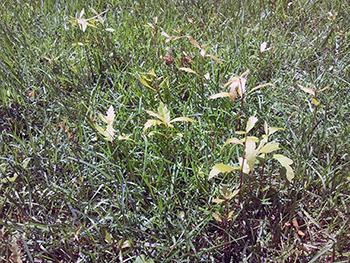Lawn Care Seasonal Guide
Caring for cool season lawns
 Ladies and gentlemen, March means it's time to start your engines. The annual lawn care routine is about to begin.
Ladies and gentlemen, March means it's time to start your engines. The annual lawn care routine is about to begin.
With so many products on the market, maintaining a healthy lawn can be confusing. There are four, five and even six step programs, not to mention the various treatments applied by commercial lawn services. The secrets to a great lawn is knowing what to do and when. It's all in the timing!
I am continually asked for simple lawn care guidelines for here in Kansas City. I have heard you and created a simplified calendar for our area’s cool season grasses (bluegrass and tall fescue).
Following is a simple month-by-month guide to help put you on the road to success.
Mid-March
Spot treat broadleaf weeds if necessary. This controls pesky spring weeds such as dandelions, henbit and chickweed. Treat on a day that is 50 degrees or warmer. Rain or irrigation within 24 hours of application will reduce effectiveness. Liquid treatments are more effective in controlling weeds that are up and growing this time of year.
Early April
Redbud trees in full bloom? Apply crabgrass preventer. The preventer needs to be watered in before it will start to work. One-quarter inch of water will be enough to water in any of the commonly available products. Remember that a good, thick lawn is the best weed prevention.
May
Fertilize with a slow-release fertilizer if you water your lawn on a regular basis during the summer. If your crabgrass control contained a fertilizer then this application may not be necessary. No additional fertilizers are needed if you let your lawn go dormant during the heat of summer.
Broadleaf weeds can be spot treated with a spray, or use a fertilizer that includes a weed killer. Rain or irrigation within 24 hours of application will reduce effectiveness of the sprayed weed killer, but the fertilizer needs to be watered in. Wait 24 hours after the application before watering if the product is a combination of fertilizer and herbicide for best weed control.
June through Mid-July
A heavy crabgrass infestation may require a follow-up application. If necessary apply a second round of crabgrass preventer in early June. Only one application is needed if you applied Dimension (Dithiopyr) or Barricade (Prodiamine) in the spring. These two products normally provide season-long control with a single application. Remember to water it in.
If grubs have been a problem in the past, apply a product containing Imidacloprid during the first half of July. This works to prevent grub damage. It must be watered in to activate.
Early September
Fertilize around Labor Day. This is the most important fertilization of the year for cool-season grass. Water in the fertilizer for best results and use a high nitrogen source. This is also the ideal time to overseed a bluegrass or tall fescue lawn.
November
Fertilize the lawn. This is the second most important time. This fertilizer is taken up by the roots but is not used until the following spring. Water in fertilizer.
Spray for broadleaf weeds even if they are small. Broadleaf weeds are much easier to control in the fall than in the spring. Spray on a day that is at least 50 degrees. Rain or irrigation within 24 hours reduces effectiveness. Use label rates for all products!

Have questions? The Garden Hotline is staffed by trained EMG volunteers and Extension staff who will assist you with questions.
Phone: (913) 715-7050
Email: garden.help@jocogov.org